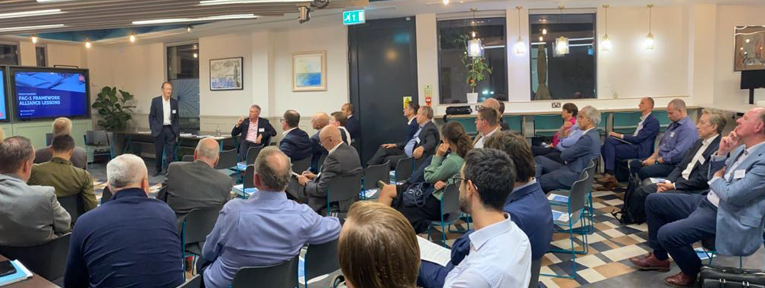Last week, we were delighted to be joined by Professor David Mosey CBE for an update and lessons learned since the launch of the FAC-1 Framework Alliance Contract.
Ed Moore opened the session, commenting that David had first introduced the FAC- 1 Framework to the ResoLex audience at a previous roundtable event in February 2018. It was therefore heartening to see the traction the framework has achieved over the last five years.
David began his presentation by explaining that the FAC-1 is a multi-party framework alliance contract that integrates the procurement and delivery of one or more different projects, with the ability to connect multiple contracts awarded to each collaborative team member. It creates the ability to establish the relationships and systems that the parties wish to use to embed collaborative ways of working, supporting the achievement of improved value, risk management and dispute avoidance.
So far, the contract has been adopted on the procurement of over £100 billion of contracts, ranging from smaller £5 million projects and SME consultant alliances to the £60 billion contractor/ consultant/ supplier procurements of the Crown Commercial Service.
Some of the key features of the FAC-1 contract are as follows:
- Creates a bridge that integrates multiple project appointments and operates in conjunction with multiple FIDIC, JCT, NEC and PPC forms
- Allows alliance members to include the client, any additional clients, an in-house or external Alliance Manager and any combination of selected consultants/ contractors/ suppliers/ providers, with the facility to add additional alliance members
- Enables the planning and integrating of a successful alliance, setting out why the alliance is being created, and stating agreed objectives, success measures and targets, with agreed incentives if these are achieved and agreed actions if they are not achieved
- States how work will be awarded to alliance members, under a direct award procedure and/or competitive award procedure and under early standard form orders
- Describes how the alliance members will seek improved value through shared alliance activities, including a collaborative system for engaging with tier 2 and 3 supply chain members
- Describes how risks will be managed and disputes avoided, using a shared risk register, core group governance, early warning and options for an independent adviser and alternative approaches to dispute resolution
- Provides the flexibility to include particular legal requirements and special terms required for any sector and in any jurisdiction.
David highlighted a number of different examples where FAC-1 has been used successfully, and one of the best examples came from the Ministry of Justice.

New Prisons complex project alliance
The UK Ministry of Justice (MoJ) created an FAC-1 Alliance to procure their £1.2 billion new prisons programme. The alliance integrates the work of ISG, Kier, Laing O’Rourke and Wates as contractor alliance members, with Mace as alliance manager, and supports their use of BIM and Modern Methods of Construction to agree on optimum designs and strategic relationships with key tier 2 supply chain members.
MoJ report that their FAC-1 new prisons alliance has meant they have been able to use the alliancing process both as a contract form and as the means to structure the relationships. This approach helped to embed the collaborative relationship early, from the alliance launch to the transition through the different phases. Each of the four contractor alliance members nominated representatives from their organisation to sit alongside representatives from the MoJ and its other delivery partners (Mace, WT Partnership and Perfect Circle). Together, they formed the Core Group, establishing strong leadership and trust from the outset.
One of the highly positive outcomes of the use of FAC-1 has been greater cost certainty and cost savings. MoJ reported that these included:
- Fees for the pre-construction collaboration phase finalised at the tender stage
- Direct fees (overheads and profit) and staff preliminary rates fixed at the tender stage
- Projected duration and contract value based on previous prison builds at HMP Five Wells and Glen Parva
- Pre-construction supply chain collaboration to build up cost certainty and savings by transparent supply chain engagement for key or critical packages on all four prisons i.e., mechanical, electrical, and plumbing engineering, pre-cast concrete, and cell windows and doors.

Final thoughts
The final message from David was that recent evidence suggests that more public sector clients are starting to look at alliancing as a beneficial method of procuring major projects and programmes of construction work. Alliancing does however require a significant shift in both mindset and behaviours, where each of the parties involved is intent on working collaboratively over a prolonged period to achieve win-win gains. In the absence of an agreed set of processes and structured agreements, there is a tendency to revert to short-term transactional behaviours.
The advantage of FAC-1 is that it provides a set of highly flexible mechanisms which are easy to set up, and then provides the programme leadership with the processes needed to create effective relationships.
You can find the round-up from the first FAC-1 roundtable on our website here: https://resolex.com/events/resolex-roundtable-building-a-supply-chain-alliance/
For anyone thinking of using the FAC-1 contract, David has written a handbook which helps clients, contractors and advisors think through some of the practical aspects of implementing the framework. You can purchase it here: https://www.amazon.co.uk/FAC-1-Framework-Alliance-Contract-Handbook/dp/1913019837
